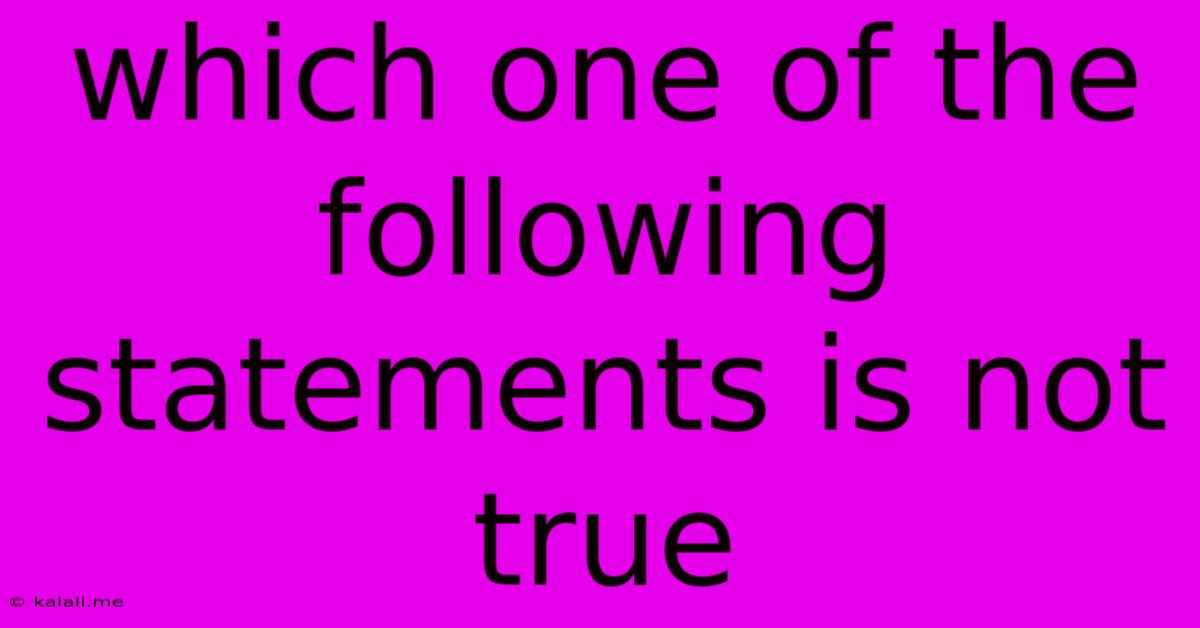Which One Of The Following Statements Is Not True
Kalali
Jun 12, 2025 · 3 min read

Table of Contents
Which One of the Following Statements Is Not True: A Guide to Critical Thinking and Fact-Checking
This article delves into the crucial skill of identifying false statements, a skill increasingly important in our age of misinformation. We'll explore strategies for evaluating claims, understanding logical fallacies, and becoming more discerning consumers of information. This is crucial for navigating online content, news articles, and even everyday conversations.
Understanding the Importance of Identifying False Statements
In today's digital world, we're bombarded with information from countless sources. Distinguishing fact from fiction is paramount for making informed decisions, forming accurate opinions, and avoiding the spread of misinformation. The ability to identify false statements is not just about finding errors; it's about developing critical thinking skills and fostering intellectual honesty. This impacts everything from personal choices to societal discourse. Being able to spot false statements is a key component of media literacy and responsible citizenship.
Strategies for Identifying False Statements:
Several strategies can help you determine which statement among several options isn't true:
1. Examine the Evidence:
- Look for Sources: Reputable sources provide evidence to support their claims. Question statements lacking clear and credible sources. Consider the authority and potential biases of the source. Is it a peer-reviewed journal, a known expert, or an anonymous blog?
- Check for Verification: Can the claim be verified through multiple independent sources? If multiple reputable sources confirm the information, it's more likely to be true. If only one source, or sources with known biases, support it, treat the claim with skepticism.
- Analyze the Logic: Does the statement logically follow from the evidence provided? Are there any gaps in reasoning or unsupported assumptions? Look for logical fallacies (discussed below).
2. Identify Logical Fallacies:
Logical fallacies are errors in reasoning that can make a statement seem true when it's not. Common fallacies include:
- Appeal to Authority: Accepting a claim as true simply because an authority figure said it, without further evidence.
- Bandwagon Fallacy: Assuming something is true because many people believe it.
- Straw Man Fallacy: Misrepresenting someone's argument to make it easier to attack.
- False Dilemma: Presenting only two options when more exist.
- Hasty Generalization: Drawing a conclusion based on insufficient evidence.
Recognizing these fallacies is crucial for spotting false statements disguised as valid arguments.
3. Consider the Context:
The context in which a statement is made is crucial. Consider:
- The Purpose: What is the aim of the statement? Is it intended to persuade, inform, or mislead?
- The Audience: Who is the intended audience? Is the statement tailored to appeal to specific biases or beliefs?
- The Time: When was the statement made? Has new information emerged since then that contradicts it?
By understanding the context, you can better assess the validity of a statement.
4. Practice Active Skepticism:
Don't passively accept information. Cultivate a healthy skepticism and question everything. Ask yourself:
- What is the evidence?
- Are there alternative explanations?
- What are the potential biases of the source?
- Does this align with my existing knowledge and understanding?
Active skepticism is a crucial tool in identifying false statements.
Conclusion:
Identifying false statements is a multifaceted skill requiring critical thinking, evidence evaluation, and awareness of logical fallacies. By employing the strategies outlined above, you can become a more discerning consumer of information and a more effective communicator, contributing to a more informed and responsible society. Remember, responsible information consumption is a continuous process of learning and refinement.
Latest Posts
Latest Posts
-
Difference Between A Quota And A Tariff
Jun 13, 2025
-
Which Chamber Of The Heart Has The Thickest Muscular Wall
Jun 13, 2025
-
Reactvity With A Base A Physical Or Chemical Property
Jun 13, 2025
-
Difference Between Square And A Rhombus
Jun 13, 2025
-
What Is The Factor Of 102
Jun 13, 2025
Related Post
Thank you for visiting our website which covers about Which One Of The Following Statements Is Not True . We hope the information provided has been useful to you. Feel free to contact us if you have any questions or need further assistance. See you next time and don't miss to bookmark.